

Termite Advice
Termite advice from a professional that specialises in termites is priceless this could just save your home from serious damage. It’s best not to take termite advice from friends or neighbours this usually ends badly.
When it comes to termites most people think big dollars, but it doesn’t have to be that way. If the homeowner is prepared to do some of the work, it can save a lot of money.
Here we will give every homeowner some tips for reducing the risk of termite attack, and it’s not that hard to do, but as mentioned it does take a bit of work at the start.
Understanding Termites
The best thing to do if you want to try and make your castle better places if termites come knocking is to have a little understanding of the harbouring and feeding habits of termites.
Firstly there are over 300 different species of termite, but only a few are of any great concern to homeowners, most termites are grass and debris eaters and have no interest in our homes.
The ones we want to keep out of our homes here in Brisbane are Coptotermes and schedorhinotermes, these two species are the most commonly found by a pest control Brisbane company when undertaking a termite inspection of a home.
Coptotermes is the termite that causes the most amount of damage to homes in Australia, this is because of its distribution, it’s found all over Australia.
Schedorhinotermes is also found throughout Australia and is a serious pest to timber in service, but Coptotermes is the worst, the giant termite Mastotermes darwiniensis is the most destructive termite, but it’s only found north of the tropics of Capricorn so it’s of no real concern for homeowners in Brisbane.
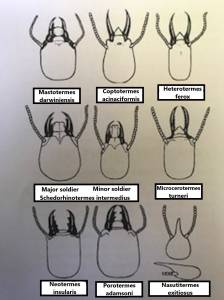

Termites are always sending out workers to find new food sources, they do this by making underground tunnels, these tunnels keep the termites safe from predators, their main one being ants.
The search for new food never stops, it goes on 365 days of the year, and their main concern is to keep the colony alive and strong, and the bigger the colony becomes the more food they need.
Termites can enter a home through a small gap in brickwork or a concrete slab or even via weep-holes, and we all know what can happen once termites have gained entry and gone undetected for a few weeks or months.
In the days before we arrived and started to build homes, termites would find their food from fallen logs or wood on the ground and even dead trees, and they still do that exact same thing today, except they have added our homes to the list, and pretty much anything manmade containing wood.
It’s a natural thing for termites to find our homes an attractive food source because to them it’s just dead wood on the ground, we call it (timber in service) but termites just look at it as a meal, they don’t know or care that it’s our home.
Each year in early summer termite colonies send out reproductives on a colonizing flight, the purpose of this is to establish a new colony; this is when a lot of people panic thinking their home is being attacked by flying termites.
Once they have landed they will soon drop their wings and start to look for a new site to try and build a new colony, most will not survive long at all and the ones that do, it’s takes years for a colony to be strong enough to cause damage to a home.


Termite nests being invaded by ants.
For the flying termites or as they are known (alates) to be successful they need to find a tree or stump before a new colony can begin, the odds on a pair making a nest in a home and building a colony is very slim indeed, that’s not to say it can’t happen, but it’s unlikely, especially if the home is having a regular yearly termite inspection done.
Termites build their nests in trees and tree stumps and also mounds, where a mound is found in a garden it’s best to destroy it with a mattock, once it’s opened up ants and birds will happily eat any remaining termites.
Where a nest is found inside a tree that is close to a house, there could be sub-nests inside the house, at this point, it’s best to call in the experts and have it carefully destroyed.
There are also some termite species that build nests on the outside of tree branches, these are generally not that interested in wood in service unless it is decay affected, these nests can be manually taken down if within range, or just keep removing the mud tunnels that are made coming down the outside of the tree trunk.
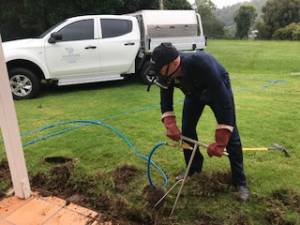

What You Need To Do To Prevent Termites
Now you have a bit of information about termites and why they like to eat our homes, you now need to try and do your best to make your home less desirable for them.
The following information is the best termite advice any homeowner will ever read as it’s from a real termite technician, that’s me in the picture.


Stored Wood Against House Not A Good Idea
The first area to consider is the garden; this area should be kept clean and tidy, this goes a long way in stopping termites, never leave wood of any kind on the ground or stacked up against the walls or fences of homes.
By stacking wood against homes or fences all you are doing is making an easy way for termites to gain access, this not only enables easy access for termites, but it also limits a termite technician when doing a visual termite inspection.
If the wood has to be stacked it should be placed onto bricks and should be at least 100mm off the ground, and stacked away from the home, it’s best to be stacked closer to the fence line, but not touching it especially if it’s a wooden fence.
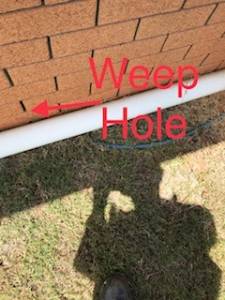

Always Keep Weep-Holes Clear
Keep grass cut low and edges kept trimmed, when grass grows up close to the wall of a house it will cover the weep-holes, these are vertical slits in the mortar between the bricks to help with airflow between the wall cavities.
When weep-holes are concealed with anything at all whether its grass, wood or some other stored item, it makes it very easy for termites to gain entry and start eating the wood inside the walls.
If there are any leaking taps on the outside of the property, especially ones that are on the side of the house, get them fixed as soon as possible, a leaking tap will make the ground moist and this will most certainly attracted termites.
The same thing goes for leaking gutters, get them fixed as soon as possible, the water that drips onto the ground will make that area constantly wet, attracting termites. Also, make sure that downpipes are connected properly to the stormwater drain.
If a home is in a high-risk area for termites, it’s best not to have plants or shrubs planted up close to the house, the main reason for this; is because the plants will need constant watering, making the ground close to the footings of the house wet; again attracting termites.
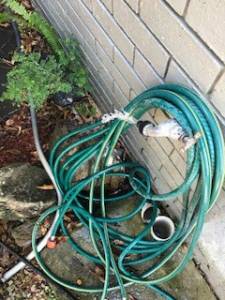

Leaking Tap
Where garden beds are close to a house, make sure that the soil is not above the weep-holes, if it is it will need to be dug out, it’s best to keep the soil line about 100mm below the weep-holes, by doing this it leaves a clear view if termites start to build mud tunnels into the weep holes.
Remove dead trees if they are close to the house and the same goes for tree stumps, these two areas are favoured nest sites for termites.
So to recap the above termite advice here is a list of things to do around the home to make it better protected against termite attack.
- Keep the outside clean and tidy
- Remove any stored items from against the house or wooden fences
- Fix dripping taps ASAP
- Fix leaking gutters ASAP
- If possible don’t plant up close to house walls (use plant pots instead)
- Keep weep-holes clear at all times
- If you have to have stored wood; stack it on bricks
- Remove dead trees and tree stumps
- Ensure downpipes are connected to stormwater drains
The above 9 points of termite advice should be carried out by all homeowners that want to protect their home from invading termites.
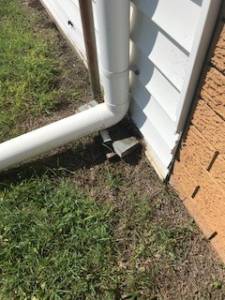

Downpipe from house
Inspect Your Home Regularly
The best termite advice from anyone let alone a termite specialist would be to check your home regularly.
Check your home regularly during the year in conjunction with a yearly professional termite inspection company. Now that we have covered how to best try and stop termites, now let’s have a look at how to find them, by checking around your home every few months.


Always inspect the roof void
The idea of following the above steps on how to prevent termites will now aid in being able to see them before they can do any serious damage.
On the outside of the property look for signs of termites, this will be in the form of small mud tunnels up brickwork or house stumps.
No matter what type of home you may have, whether it’s an old Queenslander or a slab on ground, if termites are on the attack they will show themselves at some point, you just have to find them by keeping an eye out all the time.
Firstly determine what sort of risk you think your home is at, ask around the neighbours and see if any of them have ever had problems with termites if so make your inspections a bit more often.
The place to start any inspection is outside in the garden; termite’s start from the outside and work their way in.
The tools you will need are a sounding stick, most people and some professional pest control Brisbane Company’s use the handle of a screwdriver, another tool that will be needed is a flashlight. The following termite advice is a list that will need to be checked around the inside and outside of a house during an inspection.
Here is a list of places to check during a DIY home termite inspection.
- Garden beds (look for small mounds)
- Check weep-holes (This is why they must remain visible at all times)
- Check window sills (look for mud tunnels)
- Check retaining walls
- Check trees and old tree stumps
- Check fences (especially if it’s made from wood)
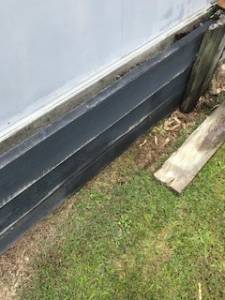

Retaining Wall
Areas to check on the inside
- Skirting boards (For the inside use a screwdriver handle to tap the wood with, if it sounds hollow it may be a sign of termites)
- Window sills
- Check walls for cupping (This could be a sign of a termite nest)
- Check door frames (Especially wet areas like bathrooms)
- Check up in the roof void (This is a must if an inspection is to be done correctly)
- Check The Sub-floor( This is an area under a house Not applicable for slab on ground homes)
After the inspection is complete write down the date the inspection was done, and repeat it a couple of times over the year.
It is also still very important to have a professional Brisbane termite inspection done at least once a year; a professional will have all the right tools to properly check behind walls etc.
Some of the tools a termite technician from a Brisbane pest control company would use are a moisture meter and a thermal imaging camera, these two items alone are way too expensive for a homeowner to invest in, but they are an integral part of a professional termite inspection procedure.
What To Do If You Find Termites
Finding termites in your home can be a shock, to say the least, and they need to be treated in a particular way, the best thing to do is call your local termite specialist for the correct termite advice.
Whatever you do don’t disturb them, this is very important termite advice, termites will close off that part of their nest and start work elsewhere, to get rid of termites from a home we need to use them against themselves.
Where termites have been found, we would place a special termite bait or dust into the mud workings, then over a period of time, the termites will unknowingly take the bait back to the main colony killing all the workers, without the workers, the queen will also die; eliminating the whole colony.
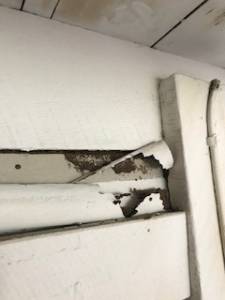

Found Termite Damage
My Final Thoughts
If you are the sort of person that doesn’t mind getting your hands dirty, then by all means do your own DIY termite inspection on your own home, but please understand use this as a back-up especially if you live in a termite prone area, but also have it check once a year by a professional pest control company.
Termites can destroy a home in no time, and the more pro-active you are the better chances you have of keeping them out, find a good termite company and work with them.
Here at Sunnystate pest control & termites, we are happy to help out anytime and give out free termite advice over the phone or by email, we like to work together with our customers and show them how to get rid of termites and keep them out.
The more aware you are as a homeowner of termites the better chance you have against them.
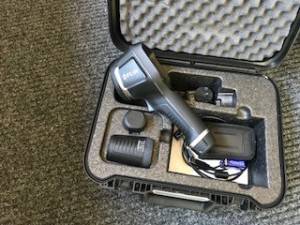

Thermal Imaging Camera

